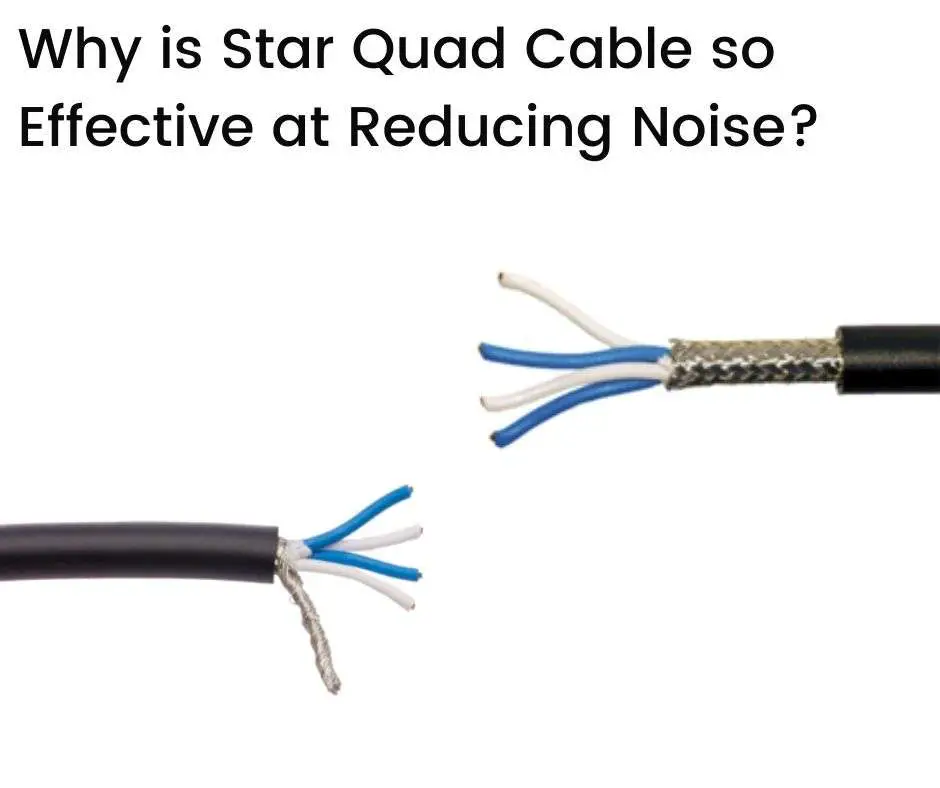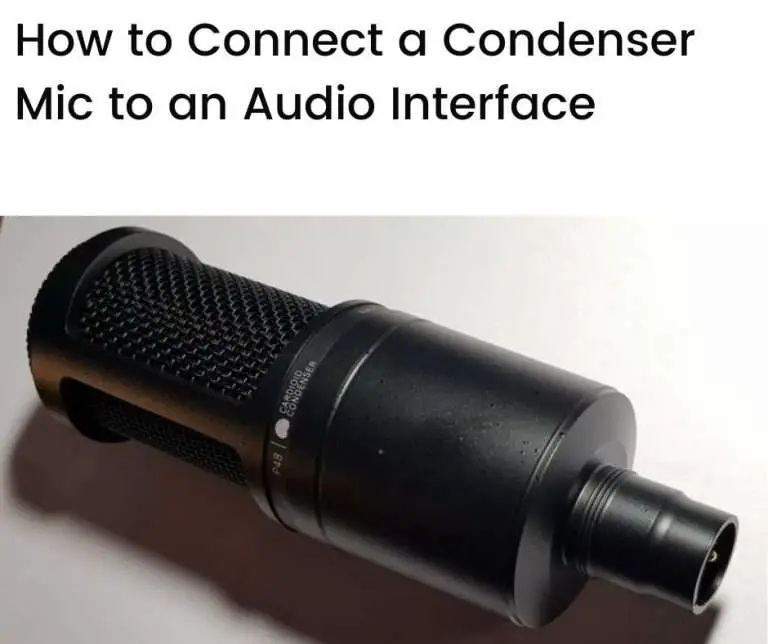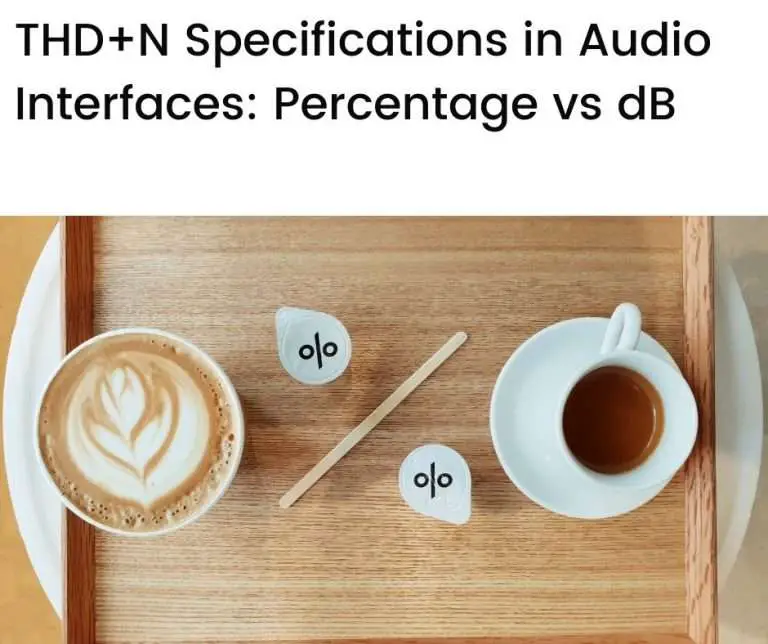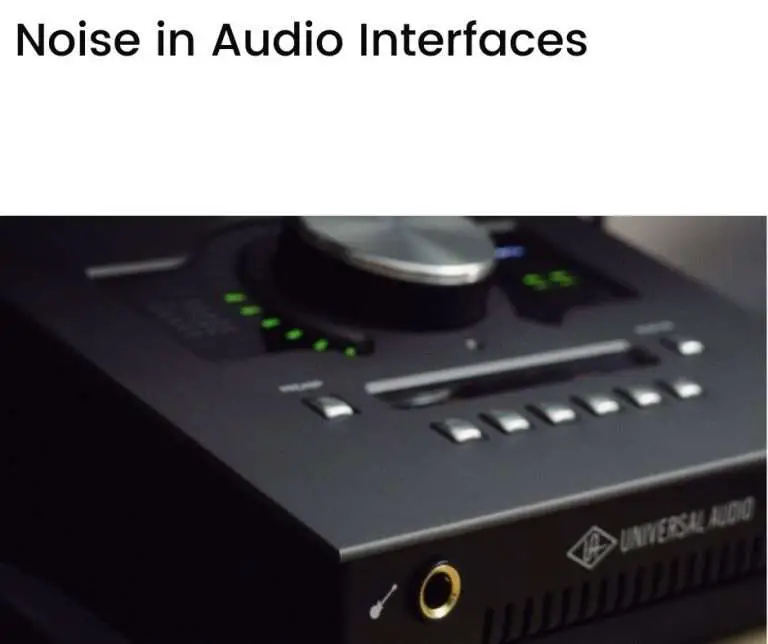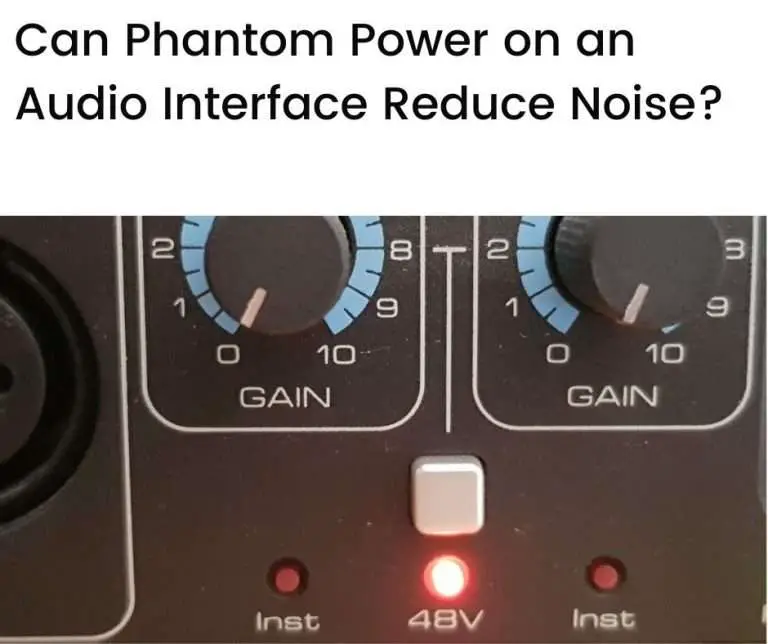Star quad cables are effective at reducing electromagnetic interference due to their unique construction, featuring a star-like configuration of four (quad) conductors. They are favored in many professional audio settings. They have two main drawbacks, however—their high capacitance levels, which can be an issue for longer cable lengths, and their high cost.
In this article we’ll look at:
- What is star quad cable?
- How do star quad cables reduce interference?
- When star quad cable is most useful
- An example of a well-constructed star quad cable
- What’s the downside of using star quad cables?
- Is star quad cable worth it?
- Conclusion
- FAQs
What is star quad cable?
Star quad cable is a type of cable that’s specifically designed to minimize interference noise. It is particularly successful at reducing magnetic interference due to its unique “star quad” configuration.
Star quad cable is a popular choice in professional audio settings due to its interference-minimizing characteristics. It can be used for connecting instruments, speaker systems, and microphones among other audio devices.
When terminated with XLR connectors, star quad cables can be used for balanced microphone connections, including for condenser microphones that require phantom power. Star quad cables are widely used for this purpose.
How do star quad cables reduce interference?
The secret to a star quad cable’s success lies in its configuration—two pairs of conductors are carefully arranged in a star-like manner that minimizes interference.
Let’s take a closer look at how star quad cables are constructed and the types of interference that they minimize.
Types of cable interference
The three main types of interference that can affect cables are electrostatic, radio frequency, and magnetic interference.
While most cables are generally well-insulated using various non-conductive materials, this insulation offers no protection from these types of interference.
Other materials and construction approaches are needed for combating interference.
Minimizing electrostatic and radio frequency interference
Electrostatic and radio frequency interference can be successfully minimized using a shield that wraps around a cable’s conductors. There are two types of shields in common use:
- Foil shielding, usually made from aluminum combined with either polyester or Kapton (a polyimide film used extensively in electronics and aircraft)
- Braided shielding, made from copper wires (bare, tinned, silver- or nickel-plated) that are woven into a mesh
Of the two, braided shielding is better at reducing electrostatic and radio frequency interference in the audio spectrum (particularly up to 15 kHz). This is due to its use of copper, which has a higher conductivity than aluminum, and the additional mass of the mesh, allowing more noise to be conducted.
Braided shielding is also very strong. The best star quad cables, therefore, use braided shielding.
Both types of shielding, however, are not effective against magnetic interference—this type of interference is far more challenging to deal with as it simply passes through metal shields.
Minimizing magnetic interference
Star quad cables are a type of balanced cable, ie. they are able to carry two signal paths on their conductors.
Simple balanced cables
A simple balanced cable would typically have two conductors—one conductor for each signal path—assembled in a twisted pair configuration.
Balanced cables are designed to reduce interference noise, but a simple balanced cable can only do this to the extent that its two conductors are identical.
This is because balanced cables minimize interference by canceling out the noise that’s common (identical) on its two conductors.
For noise to be identical, the conductors need to be identical—if they aren’t, then some of the noise will not be common between the conductors and will not be canceled out.
A well-designed balanced cable, therefore, can minimize magnetic interference even though this type of interference can pass through a cable’s shielding. As mentioned, however, this can only occur to the extent that the interference develops identically on the cable’s conductors.
As it happens, simple 2-conductor twisted pair balanced cables are not entirely effective at reducing interference. This is because its construction doesn’t allow identical interference to develop on each conductor.
The shortcomings of twisted pair for minimizing interference
For interference to develop identically on twisted pair cable, the conductors need to be physically identical to each other.
This may seem relatively simple to achieve, but in practice, several nuances make it challenging to construct physically identical conductors in a cable. These include:
- The conductors should be manufactured identically, including the calibration used in drawing the conductors into wires from their original forms
- They should have exactly the same size, ie. the same AWG (gauge)
- They should be twisted around each other with exactly the same tension, ensuring that each conductor is of exactly the same length in the finished cable (otherwise the signal on one conductor would be out of phase with the signal on the other conductor)
Getting all of these physical properties just right is not an easy task.
But, even if it could be done, there’s a further important consideration for ensuring the maximum rejection of interference on a balanced cable—the conductors need to occupy the same physical space at each point along the cable.
In a 2-conductor twisted pair cable, the conductors are located very close to each other, but they don’t occupy the same physical space.
The physical geometry of twisted pair
Consider a typical twisted pair cable—the diagram below shows a cross-section of its conductors:

If some interference, for instance, were propagating through the cable (as shown), then it would hit the first conductor a fraction of a second before it hits the second conductor—this may not seem like much of a difference, but it’s enough to prevent the noise from being identical on the conductors.
So, even though the conductors in twisted pair cables can be positioned right next to each other, their geometric positioning in physical space is different, and this works against their ability to reduce interference.
The clever physical geometry of star quad
Star quad cable gets around the issue of physical positioning by exploiting the geometric orientation of using pairs of conductors rather than single conductors.
Consider the cross-section of a star quad cable shown in the diagram below:

By arranging two pairs of conductors across from each other in a star-like configuration (as shown—one pair for each signal path in a balanced framework), the geometric center of each pair occupies the same physical space.
Hence, any interference that passes through the cable, in effect, hits each (paired) conductor at the same time. This configuration results in near-perfect cancellation of interference coming from any direction.
A star quad cable’s clever design means that it can reduce magnetically induced noise by 10-30 dB or more—a level of noise rejection that’s far in excess of what a standard 2-conductor (twisted pair) cable can achieve.
When star quad cable is most useful
Star quad cable’s interference reduction credentials make it useful in a range of situations. The following are a few examples where interference can become a serious issue, and where star quad cable can help:
- If you’re laying microphone cables next to strong sources of interference, such as power supply lines
- If you place instrument cables on or near equipment racks
- When you place instrument or microphone cables near lighting rigs or air conditioning units
- If you’re placing microphone cables in the same trenches as speaker cables
These are situations where electromagnetic interference can significantly disrupt the signals in cables, diminishing the capabilities of even the finest connected audio-visual equipment.
If these situations are likely to arise, the benefits of star quad cable become more important as the potential issues from electromagnetic interference increase.
An example of a well-constructed star quad cable
There are several companies that manufacture high quality star quad cables—Canare is one such company.
Canare was founded in Japan in 1970 and has gone on to become a global manufacturer of the highest quality cables for audio and visual applications.
The diagram below highlights the features of a well-constructed Canare star quad cable (eg. model L-4E6S).
In addition to the star quad configuration that we’ve discussed, Canare cables also use specialized insulation, durable fillers, densely braided shielding, and a tough PVC exterior. Together, these characteristics place Canare star quad cables amongst the world’s best cables for interference rejection.
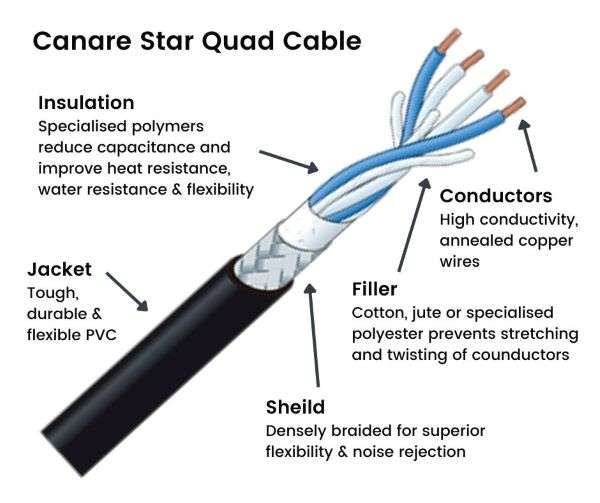
What’s the downside of using star quad cables?
If star quad cables are so effective at reducing electromagnetic interference, why wouldn’t you use them all the time rather than simpler cables like twisted pair?
The reason is that, unfortunately, there are some downsides to using star quad cables. Key amongst them are:
High capacitance
Star quad cables include more conductors (ie. four, rather than two) and typically a heavier shield (ie. with greater metal mass), hence their overall capacitance is higher—up to double that of standard twisted pair cable.
Why is a higher capacitance an issue?
A high-capacitance cable can result in a greater high frequency loss in long cable runs (such as 60-80 feet or longer).
When using dynamic microphones, such as the popular Shure SM57, for instance, a thousand feet of star quad cable can result in the high frequency bandwidth being limited to around 15 kHz—this is 5 kHz below the generally accepted frequency threshold of human hearing.
When using condenser microphones that include internal amplifiers, high cable capacitance can cause distortion. If the internal amplifier has a limited output current, it will clip high-level, high-frequency signals such as vocal sibilance or a cymbal crash.
Hence, if you’re using long cable runs in your setup, you’ll need to carefully consider the capacitance implications of using star quad cable.
High cost
Star quad cables are engineered to higher standards than regular cables and this comes at a cost—star quad cables are nearly always more expensive than comparable twisted pair cables, sometimes considerably more.
Is star quad cable worth it?
So, is it worth paying more for star quad cable?
It depends on your usage and how important interference reduction is for you.
It also depends on the amount of star quad cable that you wish to purchase, the cost savings that simpler cables offer, and the planned setup and circumstances of your cables.
Hugh Robjohns, a veteran audio technician and contributor to the industry-leading Sound on Sound magazine, says:
With [a short] cable run, and in a domestic situation, interference isn’t likely to be an issue at all. There’s no reason not to buy star quad if you can get a good deal, but I wouldn’t seek it out specially, as you’re very unlikely to gain any significant benefit.
Hugh Robjohns
As with most purchase decisions, there’s a cost-benefit trade-off to consider when it comes to star quad cables.
Conclusion
Star quad cable is a type of balanced audio cable that specializes in reducing electromagnetic interference. Its success lies in the unique star-like configuration of its conducting cores.
There are three types of interference that can affect signals in cables—electrostatic, radio frequency, and magnetic interference. Of these, the first two can be minimized effectively using shielding. The third type, however, requires a different approach as it can pass straight through shielding.
Two popular shielding types are foil and braided shielding. Of these, braided shielding performs better and is stronger than foil shielding, hence it is the preferred shielding in high quality star quad cables.
To reduce magnetic interference, the star quad configuration plays an important role.
Balanced audio cables carry two signal paths. In these cables, the rejection of interference is only successful if the signals are identical in each path.
In a standard twisted pair cable that carries two conductors (one for each signal path), it’s impossible to generate identical signals on each path due to the physical separation between the conductors—although they are close to each other they don’t occupy the exact same physical space.
In star quad cables, two pairs of conductors are used, one pair for each signal path (ie. four conductors in total).
By configuring the pairs of conductors in a star-like configuration in star quad cables, the geometric center of each pair of conductors coincides. This means that the signal paths effectively overlap in physical space, resulting in a much better rejection of interference compared to twisted pair.
Star quad cables can result in a 10-30 dB reduction of magnetic interference—far in excess of twisted pair cables.
This level of interference rejection means that star quad cables are particularly useful in situations where cables run close to other equipment, power sources, or other cables.
An example of a well-constructed star quad cable is the Canare L-4E6S. This cable features specialized insulation, durable fillers, and densely braided shielding in addition to its star quad configuration.
Despite the impressive noise-reducing capabilities of star quad cables, however, they have two main drawbacks compared to standard twisted pair cables:
- They result in a much higher capacitance than twisted pair cable—this reduces high frequency bandwidths or, in the case of condenser microphones, can produce distortion
- They typically cost more than twisted pair cable—when cable lengths are not too long, the additional cost of star quad cable may not result in any practical benefit
Star quad cables are clearly beneficial for certain needs, but they come at a cost. They are a popular choice in professional audio settings where interference can be an issue, but for simpler settings, they may be a “nice to have” but unnecessary luxury.
FAQs
What are Canare connectors?
Canare connectors are manufactured by the Canare Corporation and are used for connecting audio-visual (AV) cables. They come in a variety of types, including 75-ohm crimp, solder, and termination plugs, and 50-ohm BNC crimp plugs.
What is Canare star quad?
Canare star quad is a type of cable manufactured by the Canare Corporation. It offers excellent noise-rejection characteristics due to its unique star quad configuration.
What are XLR cables?
XLR cables are a type of balanced audio cable that typically have 3 pins—one each for positive and negative signals, and one for ground—and are used for connecting balanced microphones to audio interfaces and other devices. The name ‘XLR’ comes from the cable’s manufacturing origins, i.e., Canon Electric which referred to its X Series, Latch, and Rubber construction as ‘XLR’.
What is a shield in a cable?
A cable’s shield refers to a protective layer that surrounds the signal-carrying conductors to reduce electromagnetic interference.
What is a conductor in a cable?
A conductor in a cable is a material that carries the electrical signal. In the case of audio cables, copper is often used as a conductor.
What is electromagnetic interference?
Electromagnetic interference refers to the disruption of electronic devices caused by electromagnetic fields, which can result in distorted or noisy audio signals.
What is analog audio?
Analog audio refers to audio signals that are represented by continuously varying voltages, typically used in traditional audio systems.

